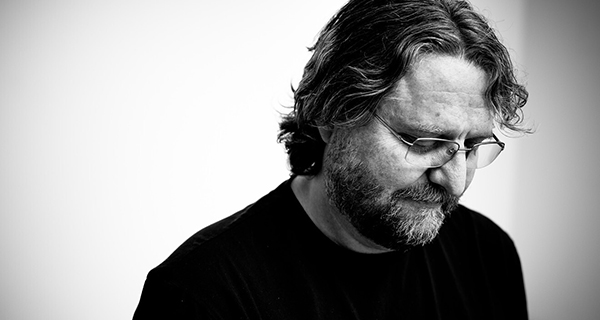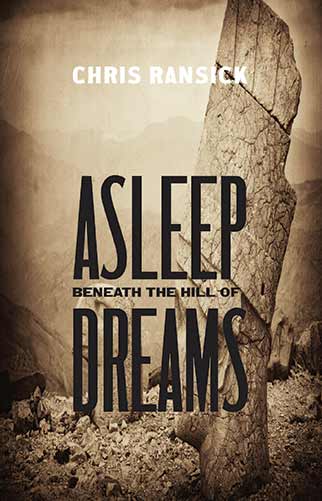
November 4, 2021 marks the two-year anniversary of Chris Ransick’s passing. Recently, Joy Sawyer sent me this interview, which I absolutely cherish. At the time of their conversation, Chris had just published Asleep Beneath the Hill of Dreams, a book of surreality and interior spaces made physical—which is perhaps the function of all dreams. Reading the interview, I’m reminded also how the book describes how we sometimes end up in the middle of our daily lives, in an endless stream of strange landscapes, and how our task is to find our truth in such places. Which, of course, is quintessentially Chris. Many thanks to Joy for letting us spend some time with Chris again.
--Michael Henry
Joy Roulier Sawyer: Congratulations on such an ambitious book. Can you tell us something of its origins? How was this “dream” birthed?
Chris Ransick: I was traveling in England back in 2004, and being in a strange place always sets loose my imagination. One afternoon I found myself in the British Museum, more than a little over-stimulated by hall after hall of mummies and Grecian urns and Sumerian statues. I felt oddly detached, images and language swirling, a state I fall into when a poem is coming, so I sat down and wrote out this surreal, tumbling, second-person voice. When it was over I had captured a kind of daydream—not a literal graph of my experience but more like what you’d find if you peeled back the experience to expose the shadowy places where impressions mingle and come to rest in the subconscious. It was kind of exhilarating to write that poem, “Dream on a Foreign Street.”
I didn’t intend to write more poems like that one, but they just kept coming. I was on a month-long tour and traveling always triggers my senses. Everywhere I went, this voice kept coming back around, and it continued when I got back to the States. Pretty soon I had a dozen poems, then twice that. I realized I was writing a kind of long poem, or maybe more accurately, a poem sequence. Each poem is in the same form, a stichic stanza with lines of about the same accentual value. I was surprised to see, when the book was laid out, that many of the poems are of about the same overall length.
JRS: You’ve spoken often of the positive impact of one of your poetry mentors, Stan Rice. Is Stan’s influence discernable anywhere in this collection?
CR: It’s hard to overstate Stan’s influence on my writing. I only studied with him for a couple years, back in 1982–83, but his poems continue to be instructive to me—the way he was so unhindered in his expressionism. You can’t get complacent in reading one of his poems because at any moment, a line can just completely throw you. The cadences he set up, the wildness of the imagery, the surprising ways he put language together—there’s a lot to learn there.
But more than that, Stan released me from a little box I was in. I was 20, passionate about writing but basically clueless, laboring to free my perspective and use of language from a Catholic boyhood and years of academic writing that had numbed me. Stan was a big, lanky, gentle Texan; he wore cowboy boots that clacked down the halls at San Francisco State U. I appreciate those boots because more than once, he gave me a figurative shove with them.
About halfway through writing Asleep, I got a little stuck, mostly because I started worrying whether the material was just too wacky for readers. Then I found a copy of Stan’s last book, False Prophet. It’s a brilliant work, written in his last year as he was suffering from brain cancer, the same thing that took my father. I could hear his voice telling me to let the animals run loose in my own work. Basically, I got the boot in my keester again. He was breaking all the rules on his way out, and that set me free once more to finish what I’d started. When something bizarre happens in my poems, which is often enough, that’s Stan’s influence all over again.
JRS: That’s interesting, as I experienced a strange, wonderful sense of vulnerability in these poems, similar to Stan’s False Prophet. In Stan’s case, he rips open his heart and mind, so that we can see clearly the brutality and beauty of his suffering.
I’m thinking the memorable, hallucinatory images in your book’s poems—"Dream of the Dying Soldier” and “New York Dreams” come to mind—are reminiscent of Berryman’s Dream Songs. Also, the second-person voice of these poems creates a driving sense of urgency for the reader. Tell us a bit about your creative instinct in using this device.
CR: That voice drove me through each of these poems, so I’m glad to hear it comes through for readers. To write each of these, I had to summon that near-trance state I mentioned earlier. It’s a filtered state—the blather around you is blocked out, yet at the same time, the senses are focused and receptive, and the subconscious mind is in play.
This is not a healthy place to occupy when, say, trying to interact with co-workers or talk to your physician, but it is the place from which the poems streamed. I’d say I was transcribing, but people would probably misinterpret that and think I meant something metaphysical. Not at all. I was transcribing from the well of the subconscious mind, what Stanley Kunitz wrote about in The Wild Braid. He said you have to be a good host to your subconscious, and the more you welcome it, the more responsive it will be.
I wrote the poems in this book over a four-year span. I was writing another manuscript parallel to this one, but not within its voice or form. Something special was happening in these dream poems and I wrote until the voice played out. It was probably the most fun, the most satisfying writing experience I’ve ever had.

JRS: You’ve said this collection “lets a monster out of the bag.” There are many disturbing images, such as the opening lines from “Dream On the Burning Mountain”: When the first flames blister your feet you know/this dream is different. What was your experience of mining “the dark side” to create this collection?
CR: I left a copy of this book with my mother when I visited her this fall and she called me recently to say, “I don’t know what you were smoking when you wrote this, but it’s kind of dark.” Well, yes. It’s been a dark passage lately in this country, and in the world in general. There’s always darkness out there. We aren’t done yet. We probably never will be.
I’m not a student of psychology but Jung’s theories intrigue me. He basically saw the subconscious mind as a wild place, not necessarily as consistently threatening as Freud asserted but still, it’s a wilderness inside us. There’s great beauty and wonder and fear in there, so when you sleep and dream, you’re subjected to whatever is on the menu. But daydreams are more intentionally pursued. The subconscious is tugging at the sleeve of the conscious mind like a kid at a carnival bugging his dad to take a ride through the funhouse. Off goes the mind to explore whatever it will—things are typically very private, and for good reason. I tried to redirect that a bit by examining landscapes. Many of the poems, even most, were written at the sites they describe, and they project outward onto the place rather than inward toward the poet.
We all have a wild human being inside our polished exterior, and by this I mean wild as Robert Bly proposed—untamed, natural, tuned to the world of the senses. When I was writing the poems in Asleep, I gave the wild thing free rein. I figured I could always choose not to publish individual pieces, or the whole book if it turned out to be too much. But I’m nearly 50 now, and aware of time passing. It’s a kind of death to be too careful. There are a handful I kept out of the book, but basically, I just let it rip.
JRS: Speaking of Jung, it’s as if these poems aren’t afraid to look “the shadow” straight in the eye, daring it to come out and play, to engage with you. It’s a bit destabilizing, in a sense, as you suggest. I’ve heard you say before that you believe “good art is disturbing.” Can you elaborate?
CR: There’s a real and important difference between being offensive and disturbing. Anybody can offend; it’s the easiest thing in the world, and of little artistic value. Frankly, I’m tired of so-called artists whose cramped and peevish imaginations are limited to clichés of obscenity and gore. It’s all so common, predictable, repetitive, and dull.
On the other hand, disturbing someone takes skill and insight, and can be a kind of gift to the reader. Complacency is our enemy in life. So many of us, myself included, get dulled by the absence of sensory stimuli in our lives; modern men and women are refrigerated in summer, warmed in winter, and spend an awful lot of time in rooms with no scent or sound or texture. Meanwhile, the mind is bombarded in meta-stimulation in the form advertising, mass media, and great gouts of useless information. It’s a wonder we aren’t all mad.
One antidote, and many people seek this out intentionally, is the state of cognitive dissonance wherein poignant, factual information shocks us out of our assumptions about the world. Sensory information is factual information—phenomena at the purest level—so a good poem can distill sensory detail for the reader. Consider how a piece of music or a painting or the gesture of a dancer’s wrist, for that matter, can bring tears to your eyes when you didn’t expect it. Suddenly, you’re alive in the world again, feeling a suddenness, disturbed out of your complacency. I want to write poems that do that, in different directions and at different levels.
JRS: Of course, in true Ransick fashion, you’ve laced these poems with a strong, gin-soaked dose of laughter, such as “Dream of the Bad Motel”: The carpet writhes beneath your shoes/like a nest of termites. Your enjoyment in writing this poem is clear. What's the story?
CR: Humor is a valuable weapon in a life that is, fairly regularly, ridiculous. There’s a time to take things seriously, but I need to counterweight that by laughing at the world, deeply and often. Kurt Vonnegut once said in an interview, to paraphrase, that laughter is just as noble as tears, and they come from about the same place inside us, something which neuroscience has confirmed.
A poem like “Dream of the Bad Motel” has some pretty grim stuff in it—I mean, it references Chivington “riding down Cheyenne children into the dirt.” That’s the Sand Creek Massacre, a low point in Colorado’s history. Not funny at all. But I was writing about an experience a friend and I had when attending a poetry festival that was very low on resources. We were put up in the worst motel ever—a real roadside abomination—and his room was worse than mine. I wrote the poem as a joke between us, a kind of nightmare recounting of the stay. Of course, it’s not literal; nothing in the book is.
But I’ve been places in Colorado and elsewhere in the American West where people still lionize the men who slaughtered and displaced native people; there’s even a street named Kit Carson Drive in one of Denver’s suburbs. I mean what are these people thinking? So to convey the absurdity of it all, I put a picture up in the motel room featuring Chivington, the bastard. It might draw a dark little chuckle from those who get what I’m saying here.

